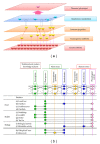Systems biology in the context of big data and networks
- PMID: 24982882
- PMCID: PMC4058291
- DOI: 10.1155/2014/428570
Systems biology in the context of big data and networks
Abstract
Science is going through two rapidly changing phenomena: one is the increasing capabilities of the computers and software tools from terabytes to petabytes and beyond, and the other is the advancement in high-throughput molecular biology producing piles of data related to genomes, transcriptomes, proteomes, metabolomes, interactomes, and so on. Biology has become a data intensive science and as a consequence biology and computer science have become complementary to each other bridged by other branches of science such as statistics, mathematics, physics, and chemistry. The combination of versatile knowledge has caused the advent of big-data biology, network biology, and other new branches of biology. Network biology for instance facilitates the system-level understanding of the cell or cellular components and subprocesses. It is often also referred to as systems biology. The purpose of this field is to understand organisms or cells as a whole at various levels of functions and mechanisms. Systems biology is now facing the challenges of analyzing big molecular biological data and huge biological networks. This review gives an overview of the progress in big-data biology, and data handling and also introduces some applications of networks and multivariate analysis in systems biology.
Figures
References
-
- Bell G, Hey T, Szalay A. Computer science: beyond the data deluge. Science. 2009;323(5919):1297–1298. - PubMed
-
- Callebaut W. Scientific perspectivism: a philosopher of science’s response to the challenge of big data biology. Studies in History and Philosophy of Science C :Studies in History and Philosophy of Biological and Biomedical Sciences. 2012;43(1):69–80. - PubMed
-
- Nakamura Y, Afendi FM, Parvin AK, et al. KNApSAcK metabolite activity database for retrieving the relationships between metabolites and biological activities. Plant and Cell Physiology. 2014;55(1):p. e7. - PubMed
-
- Kandel ER, Schwartz JH, Jessell TM, et al. Principles of Neural Science. Vol. 4. New York, NY, USA: McGraw-Hill; 2000.
-
- Kanaya S, Yamada Y, Kinouchi M, Kudo Y, Ikemura T. Codon usage and tRNA genes in eukaryotes: correlation of codon usage diversity with translation efficiency and with CG-dinucleotide usage as assessed by multivariate analysis. Journal of Molecular Evolution. 2001;53(4-5):290–298. - PubMed
Publication types
MeSH terms
LinkOut - more resources
Full Text Sources
Other Literature Sources


